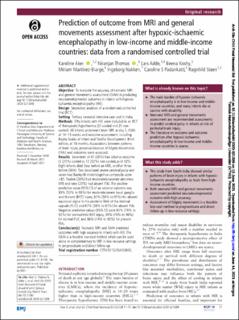| dc.contributor.author | Aker, Karoline | |
| dc.contributor.author | Thomas, Niranjan | |
| dc.contributor.author | Adde, Lars | |
| dc.contributor.author | Koshy, Beena | |
| dc.contributor.author | Martinez-Biarge, Miriam | |
| dc.contributor.author | Nakken, Ingeborg Elise | |
| dc.contributor.author | Padankatti, Caroline | |
| dc.contributor.author | Støen, Ragnhild | |
| dc.date.accessioned | 2021-10-26T07:32:52Z | |
| dc.date.available | 2021-10-26T07:32:52Z | |
| dc.date.created | 2021-06-14T14:47:49Z | |
| dc.date.issued | 2021 | |
| dc.identifier.issn | 1359-2998 | |
| dc.identifier.uri | https://hdl.handle.net/11250/2825526 | |
| dc.description.abstract | Objective To evaluate the accuracy of neonatal MRI and general movements assessment (GMA) in predicting neurodevelopmental outcomes in infants with hypoxic-ischaemic encephalopathy (HIE).
Design Secondary analyses of a randomised controlled trial (RCT).
Setting Tertiary neonatal intensive care unit in India.
Methods Fifty infants with HIE were included in an RCT of therapeutic hypothermia (25 cooled and 25 non-cooled). All infants underwent brain MRI at day 5, GMA at 10–15 weeks and outcome assessments including Bayley Scales of Infant and Toddler Development, third edition, at 18 months. Associations between patterns of brain injury, presence/absence of fidgety movements (FMs) and outcomes were assessed.
Results Seventeen of 47 (36%) had adverse outcome (5 (21%) cooled vs 12 (52%) non-cooled, p=0.025). Eight infants died (four before an MRI, another three before GMA). Two developed severe cerebral palsy and seven had Bayley-III motor/cognitive composite score <85. Twelve (26%) had moderately/severely abnormal MRI and nine (23%) had absent FMs. The positive predictive value (95% CI) of an adverse outcome was 89% (53% to 98%) for moderate/severe basal ganglia and thalami (BGT) injury, 83% (56% to 95%) for absent/equivocal signal in the posterior limb of the internal capsule (PLIC) and 67% (38% to 87%) for absent FMs. Negative predictive values (95% CI) were 85% (74% to 92%) for normal/mild BGT injury, 90% (78% to 96%) for normal PLIC and 86% (74% to 93%) for present FMs.
Conclusion(s) Neonatal MRI and GMA predicted outcomes with high accuracy in infants with HIE. The GMA is a feasible low-cost method which can be used alone or complementary to MRI in low-resource settings to prognosticate and direct follow-up.
Trial registration number CTRI/2013/05/003693. | en_US |
| dc.language.iso | eng | en_US |
| dc.publisher | BMJ Publishing Group | en_US |
| dc.rights | Navngivelse-Ikkekommersiell 4.0 Internasjonal | * |
| dc.rights.uri | http://creativecommons.org/licenses/by-nc/4.0/deed.no | * |
| dc.title | Prediction of outcome from MRI and general movements assessment after hypoxic-ischaemic encephalopathy in low-income and middle-income countries: data from a randomised controlled trial | en_US |
| dc.type | Peer reviewed | en_US |
| dc.type | Journal article | en_US |
| dc.description.version | publishedVersion | en_US |
| dc.source.journal | Archives of Disease in Childhood: Fetal and Neonatal Edition | en_US |
| dc.identifier.doi | 10.1136/archdischild-2020-321309 | |
| dc.identifier.cristin | 1915642 | |
| cristin.ispublished | true | |
| cristin.fulltext | original | |
| cristin.qualitycode | 1 | |

